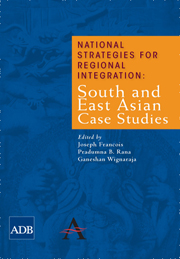2 - India
from South Asian Perspectives
Published online by Cambridge University Press: 05 March 2012
Summary
Introduction
India's recent economic performance has attracted widespread attention. With an average annual rate of growth of 8% sustained over the past few years and a robust outlook for the future, India is emerging as a driver for growth in Asia. Economic reforms undertaken since 1991 have deepened India's economic integration with the world economy, and trade and international investments now occupy a far more important place in the economy than ever. India has also taken a keen interest in regional economic integration with South Asia and East Asia. It is an active member of the South Asian Association for Regional Cooperation (SAARC) and the Bay of Bengal Initiative for Multi-Sectoral Technical and Economic Cooperation (BIMSTEC), among other initiatives for regional integration in South Asia. It has also adopted a Look East Policy to guide its foreign economic relationships and deepen engagement with the Association for South East Asian Nations (ASEAN) and East Asian countries, and has articulated a vision of broader pan-Asian economic integration.
This paper briefly overviews the macroeconomic performance of the Indian economy and the emerging patterns of its global economic integration. It also discusses India's approach to regional economic integration in South Asia and East Asia. Its sections (i) provides an overview of the macroeconomic performance of the Indian economy, the economic outlook, and global economic integration against the background of reforms undertaken since 1991
- Type
- Chapter
- Information
- National Strategies for Regional IntegrationSouth and East Asian Case Studies, pp. 23 - 96Publisher: Anthem PressPrint publication year: 2009

